| 1 | Earth’s 2nd longest snake |
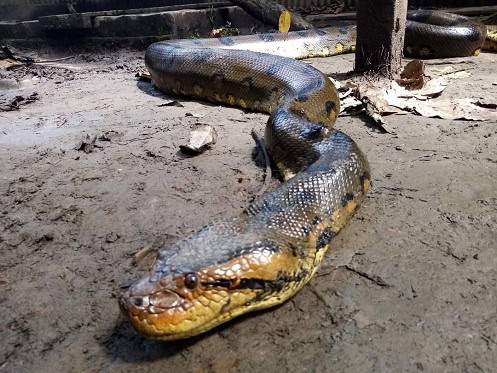
Of any animal on Earth, none has the insane library of exaggerated sizes, and tales of monstrous individuals hiding in inaccessible places humanity can’t reach, as the green anaconda (Eunectes murinus).
This infamous snake is one of 4 recognized anaconda species, and easily the most common. Yellow anacondas primarily inhabit Paraguay, Beni anacondas inhabit Bolivia, and dark-spotted anacondas far northern Brazil and French Guiana. Green anacondas, meanwhile, cover the vast majority of the Amazon rainforest, from Brazil to Peru to Venezuela. They’re a massive constrictor which lacks any venom, and are recognized as the second longest snake species after the reticulated python, edging ahead of the African rock python.
They are, however, the heaviest snake species on Earth. For example, a 5.2 metre anaconda weighs approximately the same as a 7.4 metre reticulated python, due to their thicker bodies.
Green anacondas are the most specialized of the giant snakes, as they’re nearly always found in water, including slow-moving rivers of the Amazon rainforest, rainforest swamps and humid marshland next door to forests. This is a common snake likely numbering in the millions, and there’s almost as many unbelievable tales of exaggerated sizes. Venezuelan locals have reported anacondas up to 60 or 80 feet in length. European explorers have mentioned seeing anacondas measuring 8, 9 or even 10 metres slithering past. Many a serious university professor has been swept up in the hype surrounding fantastically large anacondas.
| 2 | Drags its prey underwater |
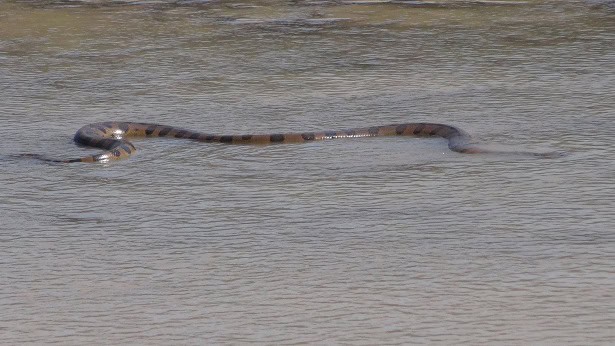
Anacondas are ambush predators, which hunt by lurking in shallow waters, then making a sudden lunge. They drag their prey into the water, even performing a death roll like a crocodile. One feature of green anacondas is that after swallowing a meal, they become immobile for weeks to digest. While a black racer can slither off instantly after swallowing a mouse, anacondas enter a digestive coma. Many large monsters have been found motionless along rivershores, such as a 30 foot (supposedly) anaconda reported by explorer Up de Graff in 1923. After almost cutting it in two with a gun blast below the head, an almost fully digested deer was found inside. Anacondas can go months without eating after a large meal.
Luckily, a green anaconda’s bite is far weaker than a crocodile of the equivalent size. Anacondas can swallow prey 146% of their own body weight, by gaping their mouths enormously wide, enabled by a loosely hinged jaw. Their jawbones have lost the solid joins and structures of other reptiles, and been replaced by looser ones.
There’s a price to pay for this – their jaws have far more flexibility than a crocodilian’s, but have lost the ability to clamp down like an industrial crusher. The advantage is occasionally being able to swallow said crocodilians.
| 3 | Capable of reaching 30 feet? |
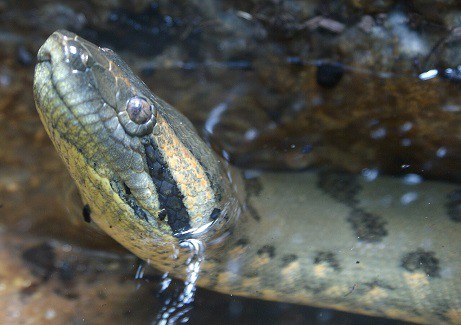
The question over the anaconda’s maximum size is the controversy that never dies. The debate has been raging since early European exploration in the 19th century, and even today, claims of 10 metres are thrown around like confetti. For example, this article from 2019 showed a green anaconda wrapped around a caiman, attempting asphyxiation as a prelude to swallowing. The article dubbed it 28 feet without any evidence.
Alfred Wallace, an associate of Charles Darwin, wrote in 1853 that “It is an undisputed fact that they devour cattle and horses“. One giant anaconda supposedly measured 7.3 metres and weighed 328lb, and was caught in the Kassikaityu River of Guyana, apparently requiring 13 men to wrestle it under control. Unfortunately, it died shortly after being airlifted to a zoo collection in the US (which is convenient).
In the early 20th century, the debate grew so feverish that New York’s Bronx Zoo offered a $50,000 reward for proof of an anaconda exceeding 30 feet, upon the request of wildlife enthusiast President Teddy Roosevelt. There was a catch though: nobody successfully completed the reward. While endless Brazilian locals have seen anacondas exceeding 10 metres, nobody has ever been able to present one.
| 4 | Rainforest river tales |
In a report from May 1921, Vincent Roth was sailing down the Barima River with natives when he found a giant anaconda in a small islet formed by a fallen tree, resting in a digestive coma. It was thick as a pork barrel, and covered with flies, but a native girl told Roth that anacondas were often covered with flies while alive. He shot the anaconda once, then pumped in bullet after bullet when it failed to move. The anaconda finally rolled over on its axis, and according to Roth, “the whole serpent was longer than our boat, and that was 28 feet“. The problem is comparing a snake to your boat isn’t a scientific method.
This happened more than once: Colombian biologist Federico Medem once described an anaconda measuring 30-40 feet, which he measured against the length of his canoe. Medem also relayed a second hand account of a 10.25 metre anaconda found on the lower Rio Guaviare, in southeast Colombia. Second hand information is common with jumbo anaconda stories.
| 5 | The official wild record |
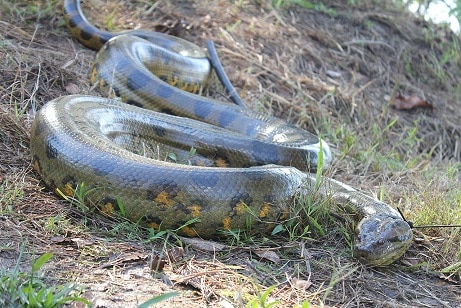
When you investigate, most of the claims of colossal monsters are manipulated somehow. This video of a 50 foot anaconda crossing a road in Brazil turned out to be horizontally stretched. The footage was real, but of a much smaller snake.
This very real footage shows a gigantic anaconda apparently getting its head caught in a chicken coop, after swimming through a lake greedily. But the video has been subtly altered in a way that tricks the human eye. The anaconda was really swimming through a small puddle, which had been made to look like a huge lake, therefore making the anaconda look equally enormous.
The official, scientifically-recognised record came in a study by Dr. Jesús Antonio Rivas, who examined 1000 wild green anacondas. The largest female measured 5.21 metres, with a weight of 214 lb 15 oz.
Back in 1946, William Beebe mentioned that the anaconda had “an accredited length of 29 feet”. However, he stated that the largest his team had found in Guyana measured 17ft 2 inches, approximately 523cm. This was shot while dangling from a tree branch above a river. This figure is strangely similar to Dr Rivas’ record.
In captivity, anacondas exceed wild lengths due to the regular food supply provided by doting keepers. The verified record is held by a female in Pittsburgh Zoo, who died on July 6th 1960 measuring 6.27 metres.
| 6 | A bullet-deflecting monster |
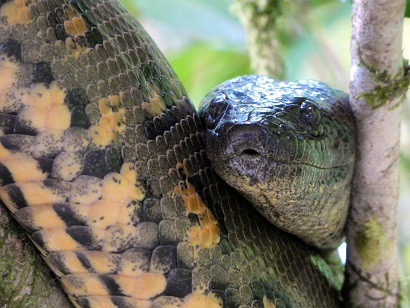
Another giga anaconda which may have glimmers of truth was an 11.5 metre snake caught by trained geologist Robert Lamon, in 1939 or 1940. Lamon was scouting the upper Orinoco river of eastern Colombia, searching for oil, when someone noticed a colossal snake in the water. His team unloaded their .45 caliber automatics at the snake, and waited until its writhings ceased. They dragged the anaconda to shore, and measured it with a steel surveying tape. The result was a whopping 11.5 metres.
The team then stopped to enjoy a bite of lunch. When they returned, the snake was gone. Their bullets had only stunned the beast, not killed it.
Importantly, Lamon measured the whole snake, and not the shed skin, which have a tendency to stretch. As a geologist, he used scientific measurement tools, not a comparison to his canoe. In 1954, Raymond M. Gilmore of the San Diego Natural History museum sent a letter to Lamon inquiring about the snake. Lamon’s response: “I do recall the Meta [River] anaconda which I killed and measured“. He remembered measuring the snake with a 4 metre steel stadia rod, and that it required three lengths of the rod to cover the snake’s body. But there was one caveat: it had been 15 years ago, and Lamon admitted that the anaconda could have been just below two lengths of his rod and not three. Therefore, it’s possible that this super anaconda measured 7.5 metres instead of 11.5m. Even so, this would easily outclass the recent record of 5.21m.
| 7 | In the depths of the rainforest |
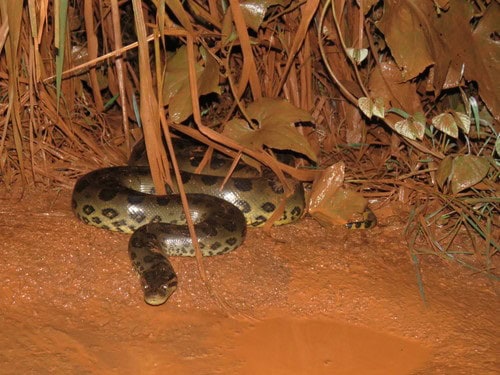
What’s the truth? Our guess is that there’s been such a long list of enormous anacondas over the years, that while the vast majority are probably exaggerated, there’s a great chance that a handful are are true. Like a diamond in the rough, or a glimmer of truth amid many empty boasts, a 7.1 metre anaconda could have been real and measured using scientific methods, but with no backup corroboration. International teams of scientists can’t be everywhere at once, nor Guinness World Records teams. In the early 1900s, some scientists had nobody but natives in wooden canoes to assist them. Many measurements were taken along rainforest rivers when South America was far less mapped out.
Reticulated pythons reguarly appear in Thai villages, or the edges of wooden boardwalks in Singapore Nature Reserves. They’re constantly intermingling with humans, making them easy to collect. Meanwhile, anacondas live far more remotely, in the depths of the Amazon rainforest, meaning that conducting proper measurements was harder.
Consider that the majority of green anacondas measured are captured from the llanoas, a huge swathe of marshy grassland situated east of the Andes in Venezuela and Colombia. The depths of the rainforest have much larger prey available, potentially allowing the anacondas to grow far larger. It’s possible that in these inner sanctuaries, where anacondas can wallow and grow old and fat to their heart’s content, away from prying human eyes, the anacondas really do reach monstrous lengths.
| 8 | Crocodilian combat |
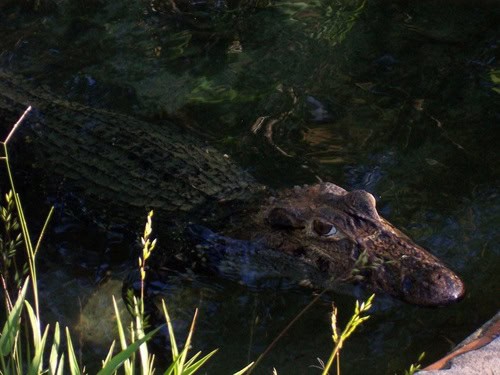
The anaconda’s largest rival in the Amazon basin rivers is the black caiman, which also reaches a maximum of just over 5 metres. This crocodilian is their nemesis, acting both as predator and prey. Battles between the two hit the headlines every few years, with newspapers showing “9 metre” anacondas coiled around a caiman’s entire body.
While the lengths are usually exaggerated, the pictures are very real. The anaconda simply applies its usual coils to a caiman and squeezes, not even always bothering to secure its snapping jaws, since caimans don’t have a very flexible neck. It seems amazing that anacondas can constrict them through their scaly armour, yet anacondas know exactly which points to pressurise, using instincts honed over millions of years.
According to a 2000 study, anacondas can capture caimans up to 55kg (121 pounds), caimans up to 55kg, and white-tailed deer up to 70kg (154lb). This study conducted a larger analysis of their diet, using anacondas from the Venezuelan llanos, and identified a large range of prey, with 25 confirmed down to the species level. The most popular prey was the savanna side-necked turtle (Podocnemis vogli), recorded 10 times.
Next came the wattled jacana (Jacana jacana), a large wading bird. White-tailed deer, whistling ducks, and caimans were eaten 5 times apiece. Most disturbingly, fellow anacondas were recorded 3 times.
| 9 | Capybara conflicts |
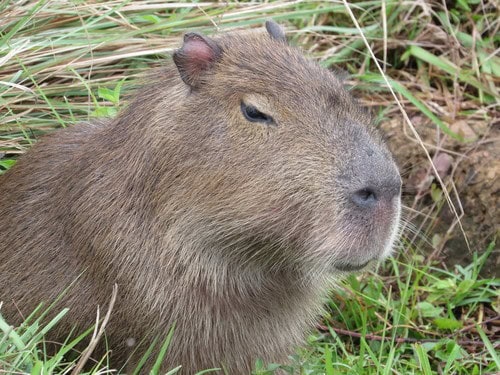
Another classic anaconda prey is the capybara, which was recorded 5 times. These are known worldwide as cute zoo exhibits which resemble giant hamsters. But capybaras also have an aggressive side, and brutal incisor teeth, which are capable of inflicting fatal wounds. Living anacondas are regularly found in Amazon rivers with old bite marks from capybaras, which are easy to identify due to their uniquely shaped teeth.
Sometimes one enemy helps another enemy, as the same study followed an anaconda called Olivia who was healthy in 1995, but became extremely ill and weak in 1996. Inspection revealed multiple capybara bite marks covering her body. Soon after, a caiman took advantage of Olivia’s weakness to eat her. This caiman was equal in size to one Olivia had previously hunted.
The final question is humans. We’re mammals, and anacondas enjoy mammals. A slim adult female can weigh 120 pounds, which is within their capabilities. In the 2000 study, the author’s female helper (121 pounds) was walking past a shallow water tributary 80cm deep. Suddenly, an anaconda called Lina made an explosive lunge, and grabbed her by the knee. She was saved only because her trousers tore, preventing the anaconda from getting a firm hold. The anaconda then lunged for her waist, its mouth open at 180 degrees, but the woman had already backed off. Lina had been tracked for 2 years, and as she measured 5.04 metres, it’s possible that she was genuinely trying to hunt the woman.
| 10 | Secret anaconda hotspots (be careful) |
If you want to find an anaconda for yourself, there’s a few secrets you’d do well to remember. The green anaconda’s basic habitats are marshes, swamps, and slow-moving rivers of the Amazon rainforest. They’re semi-aquatic snakes of water bodies, and have nostrils positioned high on the body to allow breathing.
But green anacondas go much more specific than that. They’re fussy about the clarity of the water, almost never appearing in crystal clear wetlands. Instead, anacondas appear in murky, silty and muddy waters only. They nearly always appear in shallow waters rather than deep ones, and often by the very edges.
Green anacondas are most common beneath floating vegetation, hiding them from oblivious forest creatures. Then there’s their caves. Green anacondas are especially common in natural shoreline caves formed by twisting beds of roots spiraling down from trees. When riverside forests are cut down, anacondas often disappear, as these rootbed caves rapidly erode.
Essentially, green anacondas need shelter, and the possibility for cunning disguise in their rivers. The less hospitable a swamp for humans, the more pleasant for a green anaconda.
| 11 | Longevity and babies |
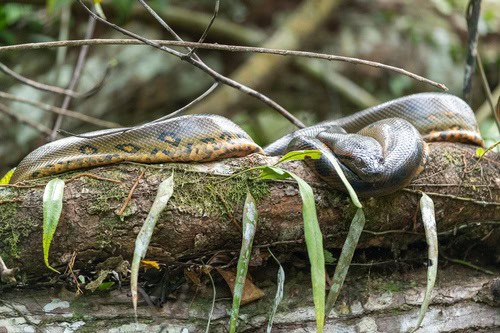
It’s estimated that even normal anacondas eat just 2-3 times a year, while females fast for the entirety of their 7 month pregnancy. This is dubbed a “capital” breeding strategy, whereby a snake relies completely on energy acquired before pregnancy, and can gather no more after the deed is done. Pregnant females become especially lazy, sticking to one muddy shoreline, whereas other anacondas can migrate over 1km to wetter areas during dry season.
Female green anacondas can lose over half their body weight after giving birth. Pregnancy is so strenuous that just one third of females reproduce in a given year. Reproducing annually would be a fantasy. Luckily, the newborn totals can be colossal, with up to 82 for larger females. Newborns measure 60cm, or two foot. They’re independent from birth, as green anacondas provide zero maternal care to their offspring.
Longevity is another green anaconda feature. The oldest ever was Annie, who resided at Monte Casino Bird and Reptile Park in Johannesburg. She died at a verified age of 37 years, 317 days. Anacondas easily break through the 20 year mark in captivity.
